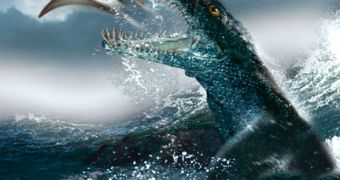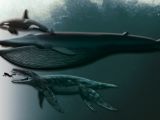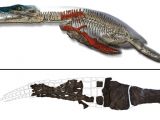This seems to be the most extraordinary reptile of the seas to have ever existed. Measuring 15 m (50 ft) in length (as much as a humpback whale) and possessing teeth the size of cucumbers, the giant marine reptile lived 150 million years ago and it was first encountered in Svalbard, a Norwegian archipelago located just 800 mi (1,300 km) from the North Pole, by a team led by J?rn Hurum of the Natural History Museum in Oslo, Norway.
In the summer of 2007, the team managed to remove a hundred tons of rock by hand, in order to recover a large part of the skeleton, including parts of its 10-ft-long (3 m) skull, an almost complete forelimb, and parts of its dinner-plate-size vertebrae.
"It's as big or bigger than the largest plesiosaur ever found. This absolutely looks like a new species," said Hurum. Plesiosaurs were sea reptiles that dominated the seas of the Jurassic. The typical plesiosaur had a small head, long neck, and large flippers resembling those of the modern sea turtles. But the new species is a pliosaur, a type of plesiosaur with short neck and massive head, like a crocodile with short Tails and sea turtle flippers.
"The newly excavated specimen is 20% bigger than what was until now the largest known pliosaur, Kronosaurus from Australia. It would have eaten other marine reptiles and maybe some of the huge bony fishes that were around at that time," said Hurum.
"Not only is this specimen significant in that it is one of the largest and relatively complete plesiosaurs ever found, it also demonstrates that these gigantic animals inhabited the northern seas of our planet during the age of dinosaurs. Amazingly, the paddle [of its forelimb] alone is nearly ten feet [three meters] long," said co-researcher Patrick Druckenmiller, a plesiosaur expert at the University of Alaska's Museum of the North.
"The site represents one of the richest accumulations of marine reptiles in the world," said Hurum.
These reptiles swam in temperate seas and their corpses fell to the ocean floor.
"Some 40 skeletons have been located to date. Most belonged to long-necked plesiosaurs and dolphin-shaped ichthyosaurs," Hurum said.
The team encountered another pliosaur specimen in 2007.
"This newest fossil may help provide pieces that are missing from Monster's partial skeleton. It seems to have more teeth, and hopefully there's more of a skull inside the hill [where it was found]. But first we have to move the hill," Hurum said.
"Pliosaurs likely had the most powerful bite force of any predator, living or extinct. Inside their enormous skulls they had huge areas of muscle available for biting force. One of these animals would have been big and strong enough to pick up a small car and bite it in half," said plesiosaur expert Richard Forrest, affiliated with the New Walk Museum in Leicester, England.

 14 DAY TRIAL //
14 DAY TRIAL // 

